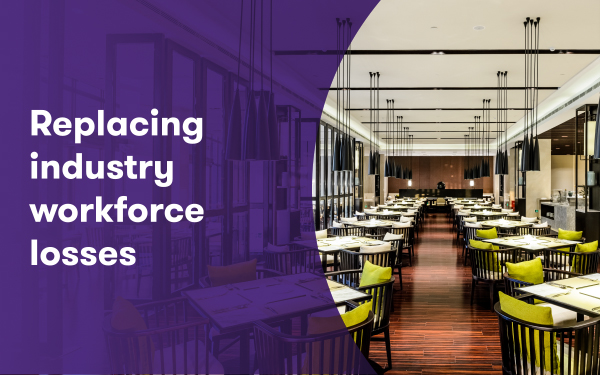After a post-pandemic rebound, restaurant and hospitality businesses have experienced a growth in consumer demand that almost matches the impact of its depression. With near universal employment today, filling job openings in these sectors is still a top concern, even as inflation and a possible recession threatens to end the growth.
Alex Rhodes, national managing partner of Hospitality and Restaurants at Grant Thornton, said National Restaurant Association figures still show a trend of continued job growth and persistent difficulties filling openings. The same is true in hospitality.
“Over the last year or so, I've had a number of conversations with those in the lodging industry,” Rhodes said. “It’s just staggering the number of unfilled job openings that are still out there in the industry.
A recent American Hotel & Lodging Association survey indicated that 90% of Americans will factor gas prices into their travel plans. The industry will be watching very closely what impact gas prices and inflation has on lodging and dining demand.” Managing workforce issues in this uncertain period must include defining strategies that attract and keep the best workers.
It’s important to further establish why talent retention is so important in the hospitality and restaurant industries, given that a high rate of turnover is normal. Why spend time training a top-notch employee only to lose that person to another restaurant or hotel – or another industry?
Because the pandemic led many workers to leave these industries for good, this trend created the challenge of both attracting and retaining talent. Rhodes said teen unemployment is at its lowest level in decades, and that means these industries, which rely so much on younger employees, must also focus on better sourcing strategies. Demand for workers is so intense that many restaurants are offering various incentives to attract and retain talent such as sign-on bonuses, 401(K)s, paid vacation, time off, and more flexible hours.
Hospitality and restaurant organizations should take note of Amazon, which in 2021 upped the ante for all by announcing it would pay four years of college tuition for employees after their 90th day, providing they continue working there at least part-time. Clearly, enticing workers through more generous benefits is a strategy that even the most successful companies feel they must pursue.
The case for talent retention
Talent retention is important even in the hospitality and restaurant industries where turnover is at an all-time high. “Reducing the rate of turnover within the first 90 days of employment, when turnover is generally the highest, should be a priority”, said Angela Nalwa, leader, HR Transformation at Grant Thornton.
“The cost of turnover is increasing and is made up of the time to source and hire a new worker, skills training and on the job training. It can take up to two months until the worker is proficient.” Both onboarding and training new employees take time and money so the less frequently you do so, the more companies can save and the less disruption to the team.
Nalwa suggested that hospitality and restaurant leaders focus on three talent attraction and retention strategies: Career development and training, compensation and rewards and employees’ perception of the organization – its values and culture.
“The important thing is for organizations to create an engaging culture and work environment that is grounded in established corporate values that their employees can relate to and feel a part of through their day-to-day behaviors and actions,” said Jennifer Morelli, Grant Thornton principal and Business Change Enablement leader.
Career development
Career development is typically a top driver of employee engagement. Morelli said whether an employee is working as a server, cleaning staff, or in management or accounting, the idea of there being growth and career development opportunities at a company is a reinforcing factor for any employee to stay with a company.
“What employees want is to know,” Morelli said, “is that somebody's looking out for them and investing in them. That's all about people management, coaching and mentoring.” Hospitality and restaurant companies are hot spots for giving people their first jobs, so there are always opportunities to be the first one to identify a quality employee. Tying even these initial forays into the working world to career advancement can be a quality investment.
Retaining high-performing people who know your organization and who understand its operations can lead to promoting those people into management and retaining front-line employees who may otherwise seek employment elsewhere. Key to this effort is to carefully identify the right people for retention. One way to do this is to make sure there is more than one evaluator of employees, so as to dilute biases that can develop in some supervisor relationships.
This emphasis on development is a particular attractor for the younger average age of employees in this industry. Nalwa said providing growth opportunities is a key way to attract younger employees who are more invested in pursuing the right career path. Companies should be sure to emphasize possibilities for growth both in the interview process and during onboarding.
Making rewards packages meaningful
While the value of pay and total rewards – everything a company gives an employee that can be considered valuable – may not be decisive in every industry, it is in hospitality, Nalwa said. If your employees are mainly hourly, besides salary, other forms of compensation such as an education discount, tuition reimbursement or healthcare benefits can make enough of a difference for employees to stay. Nalwa pointed out firms that have been successful when providing transportation to workers who live close by, a timely benefit given high gas prices.
The restaurant and lodging organizations that are offering these benefits are setting themselves apart and making them more attractive to employees, both from an attraction and retention perspective.
“What’s really important is to understand what your employees value before shaping a total rewards package,” Nalwa said. To do that, company leaders must effectively listen to what their workers say is important. And your frontline worker might have a different value for certain rewards than your corporate vice president. While healthcare may be important to most, some data suggests it’s not as critical to younger workers, so there are opportunities to find compensation awards that cost less or are even cost-neutral.
Leaders in these industries who wish to effectively listen to the benefits their employees say are most valuable is mostly a matter of finding the right tools and being as objective as possible. Employer surveys are a great tool and can produce hard data to aggregate needs, even uncovering what needs aren’t being met that benefits could address. Surveys can ask about what causes employees the most stress – and the benefits can be tailored to lessen those stressors.
Finding out what needs your employees prioritize is only the first step. A company has to determine what it can and should deliver to address those needs. “We have to make trade-offs in reality,” said Tim Glowa, a principal of Human Capital Services at Grant Thornton, by judging receptivity to employee needs and stress reducers with an assessment of their cost. “Most organizations waste between 10% and 20% of their employee benefits budget by giving employees what they don’t actually appreciate,” Glowa added.
Glowa shared that in one major national food chain, it was uncovered that many employees worked multiple jobs to provide more money to create opportunities for their families. By offering employees a tuition reimbursement they could use both personally and pass on to immediate family members, this benefit addressed the opportunity that higher education could yield for their family. The benefit was also highly differentiated in that it was not offered by competitors. Furthermore, their employees assigned greater value to this benefit than it cost the company – a company cost-saving benefit.
From our survey, we know a significant driver of stress for employees, no matter what the industry, is personal debt, which is front-and-center for many employees in the restaurant and lodging industries. An innovative company can use this information to implement cost-effective ways to reduce this stressor on its employees – support for credit card payments, utility bills, professional budgeting or money management assistance. Organizations that identify these types of employee stressors and offer benefits to help alleviate them differentiate their employee value proposition in a meaningful way in the eyes of employees, adding to attraction and retention efforts.
Matching values to employees
“Not everyone is going to fall in love with a company that just offers them a job,” Morelli said. “Employees have their personal values and ways of living and working that they will bring to the job – it’s important for management to look at a company’s reputation and what the organization stands for as part of their talent attraction and retention strategy.
Many employees, particularly younger ones, care deeply about the culture of the company that they work for, Morelli said. Employees want to align themselves to companies that outwardly demonstrate the same beliefs that they have. Many also want to feel a strong connection to their community and want to work for companies whose charitable involvement aligns with their values.
In many cases, leadership that demonstrates clear company values can be a high-risk/high-reward strategy, especially if a company value aligns with a particular social issue or political belief which may both strongly attract and strongly repel quality employees. A company can show trust and accountability by how they value community service and charitable work, and particularly by ensuring diversity, equity and inclusion are demonstrated values and not empty declarations.
A company must be able to demonstrate that its workplace ensures that day-to-day interactions of employees are conducted with respect and that opportunities for advancement should be quantifiable, shown by employee surveys and programs.
For example, many employees in the restaurant and lodging industries are required to work overtime hours that they don't want to work, mainly due to the staffing shortages mentioned earlier. One way to help with both recruiting and retention is to clearly state in company policies that employees won’t need to work an undesirable number of hours – or that concrete steps are being taken to reduce those hours soon.
Another way for leaders to manage any worker shortages is to cross-train employees. This approach can also make a company more valuable to an employee by providing more variable work. For restaurants, Rhodes said, that includes efforts to make the “back of the house” work in the kitchen more interchangeable, so workers can, and sometimes must, fill different roles each day. When you do that, it’s easier to cover absences and it’s easier to hire replacements.
Technology is also playing a role, Nalwa said, in that computers can take over many rote roles, such as reservation-making, that can free staff for more fulfilling tasks.
Setting expectations – and following through
Addressing all three of these strategies – career development, compensation and rewards and meeting personal and professional values – requires a level of transparency and engagement about company matters that can be uncomfortable for some leaders. To effectively manage employee attraction and retention efforts, corporate communications and leadership should be clear and consistent, including clear expectation-setting. If any change is to occur, employees should feel like they are part of the change instead of it just happening to them.
“When you introduce a sense of uncertainty or potentially remove the sense of control from employees you insert a sense of fear.” Morelli said. “Most individuals will begin to create their own narrative around what the future will be and unfortunately most of the times it’s inaccurate and at times negative.” Through openness and frequent communication, a company isn’t adding roadblocks to what employees are doing, they are helping employees navigate those roadblocks, understanding why changes are happening and preparing them for the future state of the organization.
“I'm very bullish on the industry,” Rhodes added. “According to survey data , there's a lot of pent-up demand.”
The challenge this presents is to ensure that the customer service provided meets consumer expectations. That means prioritizing, attracting and retaining staff, Rhodes said. “Businesses want to give their diners and guests a good experience and it’s essential a business has the professional staff to do just that.”
Contacts:
Trending topics

No Results Found. Please search again using different keywords and/or filters.




Share with your network
Share